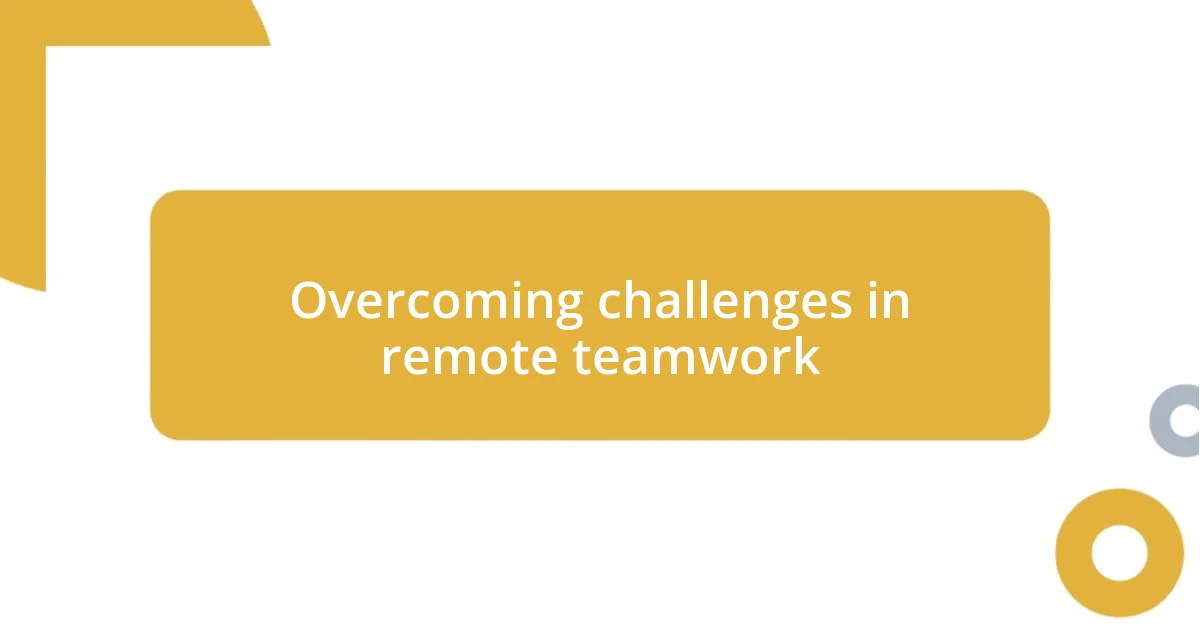Key takeaways:
- Effective online collaboration tools enhance productivity and communication, allowing teams to work efficiently from anywhere.
- Key features to look for in collaboration tools include user-friendliness, customizability, and integration with other applications to streamline workflows.
- Overcoming challenges in remote teamwork, such as isolation and time zone differences, can be addressed through open communication and establishing guidelines.

Understanding online collaboration tools
Online collaboration tools have truly revolutionized the way we work together, no matter where we are. I remember my first experience using a tool like Slack; it felt almost magical to communicate instantly with colleagues across different time zones. Have you ever felt that rush when a simple message leads to a breakthrough idea? It’s a reminder that collaboration isn’t just about technology—it’s about connection.
These tools come in various forms, from project management software like Asana to video conferencing platforms like Zoom. I often find myself switching between them, and it’s incredible how each platform offers unique features tailored to different needs. It makes me wonder, how did we ever manage before these became a staple in our daily work? This diversity allows teams to harness creativity and efficiency that were previously hard to achieve.
As I worked on a group project recently, I realized that the effectiveness of online collaboration tools hinges on how we use them, not just their features. For instance, I learned the importance of setting clear communication guidelines to avoid misunderstandings; it transformed our workflow entirely. Have you thought about how specific tools facilitate your team dynamics? It’s fascinating how the right tool can elevate both productivity and camaraderie.

Benefits of using collaboration tools
Using online collaboration tools has significantly enhanced my workflow and the way I connect with my team. I remember a time when we were juggling multiple projects and struggling with miscommunication. When we started using Trello, it felt like a breath of fresh air. Suddenly, everything was organized, and our tasks were visible to everyone. That transparency built a sense of accountability that I hadn’t experienced before.
Here are some key benefits I’ve noticed:
- Increased Productivity: Tasks are easily tracked and managed, ensuring deadlines are met.
- Enhanced Communication: Instant messaging and comments keep conversations flowing seamlessly.
- Flexibility: Team members can collaborate from anywhere, allowing for a better work-life balance.
- Diverse Tools: Each platform offers unique features that cater to different project needs, fostering creativity.
- Stronger Team Dynamics: Working together in a shared digital space creates a sense of unity and purpose.
In my latest project, using Google Docs made collaborative writing a game-changer. I felt relieved knowing that even during the busy times, my teammates could contribute asynchronously. It’s amazing how these tools can transform an otherwise overwhelming task into a shared journey.

Key features to look for
When choosing online collaboration tools, there are several key features that can make all the difference in your team’s productivity. Firstly, user-friendliness is essential. I recall my initial struggles with a complex project management tool that felt more like a chore than a help. It’s vital to find a tool that your team can adopt easily, allowing everyone to focus on the work rather than learning the software.
In addition to simplicity, customizable options can enhance teamwork. For example, when I started using Monday.com, I was thrilled to discover how I could tailor the dashboard to fit our specific project needs. This level of adaptation truly empowered my team, as we could highlight what was most important to us, making our collaboration not just effective but also enjoyable.
Lastly, robust integration with other applications is a feature that should not be overlooked. I remember feeling frustrated when I had to switch between different platforms for various tasks. Then I found tools that seamlessly integrated with Google Workspace and other apps we were already using. This integration made a big difference in keeping everything organized and efficient. Have you also experienced the struggle of juggling multiple tools? It’s a challenge, but the right features can simplify our work significantly.
| Feature | Description |
|---|---|
| User-Friendliness | Ease of use is crucial for quick adoption by team members. |
| Customizability | Allows teams to tailor tools to specific project needs, enhancing engagement. |
| Integration | Supports seamless connection with other apps to streamline workflows. |

Popular online collaboration platforms
When it comes to popular online collaboration platforms, Slack stands out in my experience. I remember joining a team that used it for everything from quick notes to elaborate project discussions. The instant messaging feature allowed us to share ideas on the fly, which was particularly useful during brainstorming sessions. Have you ever felt your ideas spark when they’re fresh? Slack enabled us to capture those moments effortlessly.
Another platform I’ve come to appreciate is Asana. The first time I used it, it felt like someone handed me a crystal-clear map through a dense forest of tasks. I was once part of a project that seemed like it would spiral out of control, but Asana’s clear task assignments and deadlines brought serenity to the chaos. It’s incredible how visual project management can simplify even the most complex workflows, right?
Microsoft Teams is another contender that resonates with many organizations. I recall being part of a quarterly meeting where we used Teams for real-time document collaboration. The ability to edit documents while discussing them saved us so much time! It’s fascinating how these platforms bring people together, whether remotely or in a hybrid setup, turning what once felt like a burdensome meeting into an engaging, efficient discussion.

Best practices for effective collaboration
Staying organized is one of the best practices I’ve learned for effective collaboration. I vividly remember a project where a simple shared calendar saved us from multiple scheduling conflicts. It felt liberating to see everyone’s availability at a glance, which made planning meetings a breeze. Have you ever faced the chaos of finding a mutual time, only to end up frustrated? A shared calendar can truly be a game changer.
Another key aspect is maintaining open communication. In one of my projects, I noticed that weekly check-ins kept everyone aligned and motivated. Those brief moments to touch base not only helped us address concerns but also reinforced team camaraderie. How often do you have those touchpoints? Regular communication fosters an environment where everyone feels valued and heard.
Lastly, it’s imperative to set clear goals. I once participated in a team where we worked toward a vague deadline, and it quickly led to confusion and frustration. However, when we broke the project down into specific, measurable objectives, the entire atmosphere changed. Goals act like a compass, guiding us toward success. Have you also experienced the magic of clarity in a collaborative setting? It truly can propel your team forward.

Overcoming challenges in remote teamwork
One challenge I’ve faced in remote teamwork is the feeling of isolation. I remember a time when our group was working on a critical project, yet we barely spoke outside our scheduled meetings. This silence created a disconnection that impacted morale. Have you ever felt like a ghost in your own team? That’s when I proposed a casual weekly coffee chat, no agenda—just sharing thoughts. It transformed our dynamic, reminding us that we’re more than just colleagues on a screen.
Another hurdle is managing different time zones. I once joined an international team where coordinating meeting times felt like solving a puzzle. It was frustrating at times, but I learned to use tools that show overlapping hours for all team members. Do you struggle with time discrepancies, too? The solution I found was creating a rotating meeting schedule, which ensured that no one felt consistently sidelined. It not only streamlined our meetings but also fostered a sense of equality among team members.
Lastly, the variety of communication styles can be a roadblock. I vividly recall working with a teammate who preferred concise messages while I thrived on elaboration. This difference led to misunderstandings. Have you encountered similar issues in your collaborations? I found that establishing mutual communication guidelines—like summarizing key points after discussions—can bridge these gaps. It allowed us to leverage our unique styles instead of feeling hindered by them.

Measuring success of collaboration efforts
Measuring the success of collaboration efforts can often feel ambiguous, but I’ve learned a few tangible methods that really give insight. For instance, tracking project milestones helped my team stay on course during a particularly challenging project. Every time we hit a milestone, I felt a surge of motivation—how about you? Celebrating small wins can go a long way in reinforcing the effectiveness of our collaboration.
Another valuable approach I’ve adopted is gathering feedback from team members. After completing a project, I once initiated an anonymous survey to gauge everyone’s feelings on our collaboration experience. I was surprised to find that while some loved our workflow, others felt overwhelmed by constant updates. This insight allowed us to refine our approach for future projects. Can you recall a time when you adjusted course based on feedback? It truly makes a difference when everyone’s voice is considered.
Finally, assessing outcomes against initial goals is crucial. During one project, we set clear KPIs (Key Performance Indicators) to evaluate our efforts, and that clarity allowed us to identify areas for improvement. At the end, we realized one key focus area was lagging, prompting a team discussion that sparked some innovative solutions. Don’t you think reviewing our expectations versus reality can lead to growth? Reflecting on this has taught me that adjusting our strategies post-reflection is just as important as the collaboration itself.













